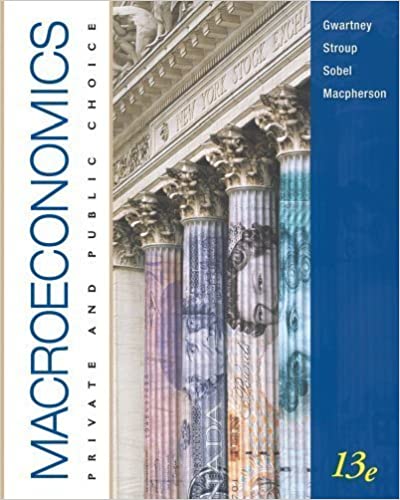
Microeconomics 13th Edition by Russell Sobel, David Macpherson, Richard Stroup, James Gwartney
Edition 13ISBN: 978-0538452281
Microeconomics 13th Edition by Russell Sobel, David Macpherson, Richard Stroup, James Gwartney
Edition 13ISBN: 978-0538452281 Exercise 3
*Use the information in Exhibit of this chapter to answer the following:
Exhibit
The Short-Run Demand Schedule of a Firm
Compute-Accounting, Inc., uses computer technology and data-entry operators to provide accounting services in a competitive market. For each accounting statement processed, the firm receives a $200 fee (column 4). Given the firm's current fixed capital, column 2 shows how total output changes as additional data entry operators are hired. The marginal revenue product (MRP) schedule (column 6) indicates how hiring an additional operator affects the total revenue of the firm. Because a profit-maximizing firm will hire an additional employee if, and only if, the employee adds more to revenues than to costs, the marginal revenue product curve is the firm's short-run demand curve for the resource (see Exhibit 5).
 a. How many employees (operators) would Compute- Accounting hire at a weekly wage of $250 if it were attempting to maximize profits?
a. How many employees (operators) would Compute- Accounting hire at a weekly wage of $250 if it were attempting to maximize profits?
b. What would the firm's maximum profit be if its fixed costs were $1,500 per week?
c. Suppose there were a decline in demand for accounting services, reducing the market price per monthly statement to $150. At this demand level, how many employees would Compute-Accounting hire at $250 per week in the short run? Would Compute- Accounting be able to stay in business at the lower market price? Explain.
Exhibit
The Short-Run Demand Schedule of a Firm
Compute-Accounting, Inc., uses computer technology and data-entry operators to provide accounting services in a competitive market. For each accounting statement processed, the firm receives a $200 fee (column 4). Given the firm's current fixed capital, column 2 shows how total output changes as additional data entry operators are hired. The marginal revenue product (MRP) schedule (column 6) indicates how hiring an additional operator affects the total revenue of the firm. Because a profit-maximizing firm will hire an additional employee if, and only if, the employee adds more to revenues than to costs, the marginal revenue product curve is the firm's short-run demand curve for the resource (see Exhibit 5).
 a. How many employees (operators) would Compute- Accounting hire at a weekly wage of $250 if it were attempting to maximize profits?
a. How many employees (operators) would Compute- Accounting hire at a weekly wage of $250 if it were attempting to maximize profits?b. What would the firm's maximum profit be if its fixed costs were $1,500 per week?
c. Suppose there were a decline in demand for accounting services, reducing the market price per monthly statement to $150. At this demand level, how many employees would Compute-Accounting hire at $250 per week in the short run? Would Compute- Accounting be able to stay in business at the lower market price? Explain.
Explanation
The short-run demand schedule of Compute...
Microeconomics 13th Edition by Russell Sobel, David Macpherson, Richard Stroup, James Gwartney
Why don’t you like this exercise?
Other Minimum 8 character and maximum 255 character
Character 255


